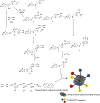Cancer cells inhibition by cationic carbon dots targeting the cellular nucleus
- PMID: 36701865
- PMCID: PMC9957951
- DOI: 10.1016/j.jcis.2023.01.086
Cancer cells inhibition by cationic carbon dots targeting the cellular nucleus
Abstract
Nucleus targeting is tremendously important in cancer therapy. Cationic carbon dots (CCDs) are potential nanoparticles which might enter cells and penetrate nuclear membranes. Although some CCDs have been investigated in nucleus targeting and applied in nuclear imaging, the CCDs derived from drugs, that are able to target the nucleus, bind with DNA and inhibit the growth of cancer cells have not been reported. In this project, 1, 2, 4, 5-benzenetetramine (Y15, a focal adhesion kinase inhibitor) derived cationic carbon dots (Y15-CDs) were prepared via a hydrothermal approach utilizing Y15, folic acid and 1,2-ethylenediamine as precursors. Based on the structural, optical, and morphologic characterizations, Y15-CDs possess rich amine groups and nitrogen in structure, an excitation-dependent photoluminescence emission, and a small particle size of 2 to 4 nm. The DNA binding experiments conducted through agarose gel electrophoresis, UV-vis absorption, fluorescence emission, and circular dichroism spectroscopies, prove that Y15-CDs might bind with DNA via electrostatic interactions and partially intercalative binding modes. In addition, the cell imaging and cytotoxicity studies in human foreskin fibroblasts (HFF), prostate cancer (PC3) and osteosarcoma cells (U2OS) indicate the nucleus targeting and anticancer abilities of Y15-CDs. Most interestingly, Y15-CDs exhibit a higher cytotoxicity to cancer cells (PC3 and U2OS) than to normal cells (HFF), inferring that Y15-CDs might be potentially applied in cancer therapy.
Keywords: 1,2,4,5-benzenetetramine; Cancer therapy; Cationic carbon dots; DNA binding; Nucleus targeting.
Copyright © 2023 Elsevier Inc. All rights reserved.
Conflict of interest statement
Declaration of Competing Interest The authors declare that they have no known competing financial interests or personal relationships that could have appeared to influence the work reported in this paper.
Figures














References
-
- Duncan R, Nanomedicine gets clinical, Materials Today 8(8) (2005) 16–17. 10.1016/S1369-7021(05)71032-4. - DOI
-
- Wang B, Song H, Qu X, Chang J, Yang B, Lu S, Carbon dots as a new class of nanomedicines: Opportunities and challenges, Coordination Chemistry Reviews 442 (2021) 1–18. 10.1016/j.ccr.2021.214010. - DOI
MeSH terms
Substances
Grants and funding
LinkOut - more resources
Full Text Sources
Medical

